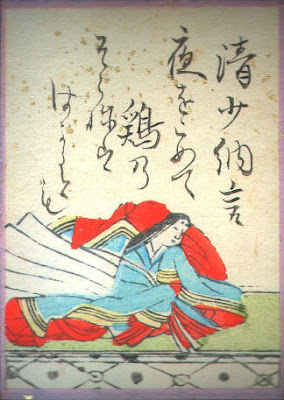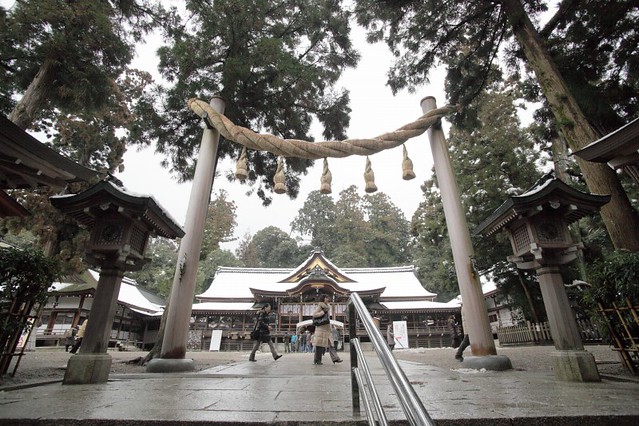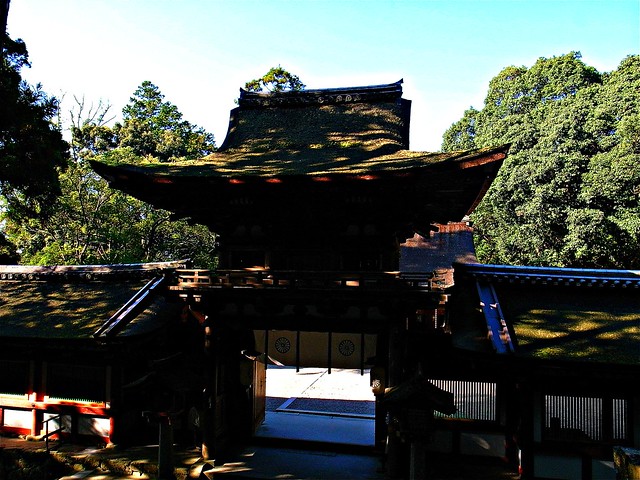The montain was already covered with turf by 1255. Legend has it that it was derived from a boundary dispute between Kofuku-ji Temple and Todai-ji Temple 1760. However, according to a record which was discovered recently, farmers set on fire to encourage new growth and prevent wild animals from causing damage to farms. It is said that the event has been held every year since 1760.
 |
| Procession to the bonfire by iriskh /flickr 2013-01-26 |
Each of ten monks lights a torch from the sacred fire in Kasuga Taisha Shrine.
After going in procession to Nogami Shrine for praying safety, they go to a big bonfire.
 |
| Procession to the bonfire by iriskh /flickr |
 |
| Yamayaki by scjody /flickr |
 |
| Yamayaki by scjody /flickr |
 |
| Wakakusa Yamayaki (Roasting Mt Wakakusa in Nara) by iriskh /flickr |
They light a big bonfire at the foot of Mt. Wakakusa.
 |
| Wakakusa Yamayaki Bonfire by iriskh /flickr |
Fireworks are set off.
 |
| Wakakusa Yamayaki Fireworks by iriskh /flickr 2013-01-26 |
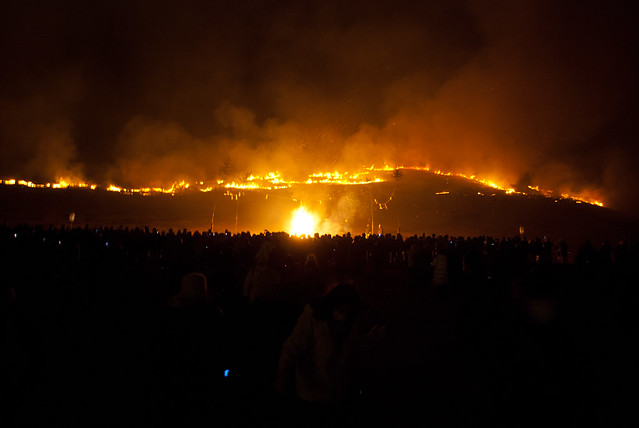 |
| Nara Mountain burning (Yamayaki) by nwhitely /flickr 2012-01-28 |
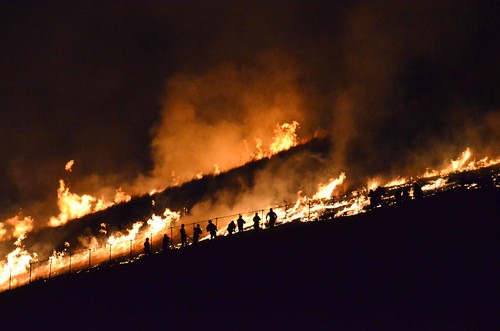 |
| Wakakusa Yamayaki (Roasting Mt Wakakusa in Nara) by iriskh /flickr 2013-01-26 |
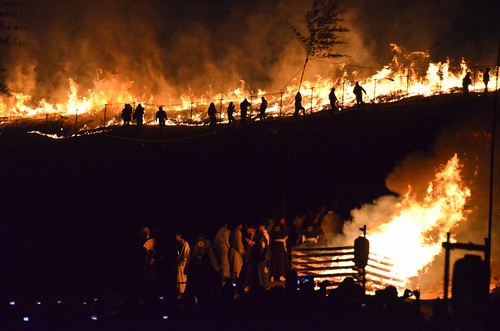 |
| Bonfire + Grassfire at Wakakusa Yamayaki by iriskh /flickr 2013-01-26 |
Each of firefighters lights a torch from the bonfire. The monks set fire to grass lands first, then the firefighters do it at their posts as one.
 |
| Wakakusayama Yamayaki by Sam Sheffield /flickr 2010-01-23 |
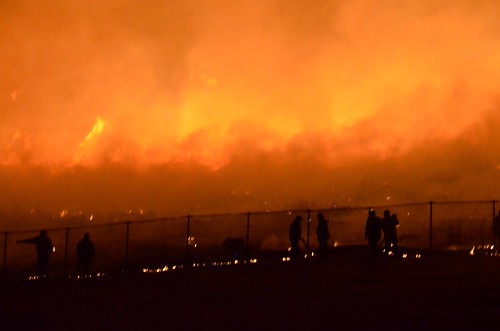 |
| Wakakusa Yamayaki (Roasting Mt Wakakusa in Nara) by iriskh /flickr 2013-01-26 |
The dead grass on the mountain burn out in 30 minutes.
They give their full attention not to cause a fire in adjacent Kasugayama Primeval Forest.
In most areas of Japan, grasslands turn into forests if they are not cared for. Controlled burning has been traditionally conducted to turn out catlle and horses onto fresh pasture, and to gather Japanese silver grass(susuki) and common reed for thatched roofs. The controlled fire can prevent future fire and damage from insects. Wood ash is beneficial to the newly sprouting grass.
In Japan, meat-eating was a taboo or was officially prohibited for Buddhist beliefs from 675 to 1872 although some people secretly ate meat. Horses were raised for military and transport use. Cows were raised for transport, ceremonial and agricultural use.
Semi-natural grasslands are important to maintain biodiversity, but they have greatly declined in Japan. Many plant and insect species are threatened with extinction.
Prescribed burns are done in many areas, but may be delayed due to weather conditions. In the past, prescribed burns has caused several accidents in Japan.
The mountain-burning event at Mount Omuro (大室山, Omuro-yama) in Ito City, Shizuoka Prefecture will be held on February 10th.
Mount Omuro was a producer of Japanese silver grass for thatched roofs. It is said that controlled burning in this area started to encourage new growth of them about 700 years ago.
The mountain-burning event at Akiyoshi-dai (秋吉台) in Yamaguchi Prefecture will be held on February 17th.
Akiyoshidai is the largest karst plateau in Japan and is thought to have been a primeval forest in ancient times. Although by the 19th century this area was already a grassland region, it's unknown when this event was started. Controlled burning was done to enrich the soil with ash, gather pasture, and prevent future fire. Now it's done mainly to maintain grassland and attract visitors.
Controlled burning(Noyaki) at Hiraodai(平尾台) in Fukuoka Prefecture will be done on February 24th. Hiraodai is a famous karst plateau.
The mountain-burning event at Sengokubara(仙石原) in Hakone, Kanagawa Prefecture will be held on March 8th. Sengokubara is also famous for its fields of susuki grass and was a place to gather susuki grass for thatched roofs.
Controlled burning(Noyaki) at Mount Sanbe(三瓶山, Sanbe-san) in Oda City, Shimane Prefecture will be done in late March.
According to a record, the local lord started to turn cattle out to graze in 1643. Controlled burning was restarted in 1989, cattle grazing was done in 1996. The moderate grazing pressure helps to maintain biodiversity. The area is being returned to its former appearance.
 |
| photo by 神戸観光壁紙写真集 Tonomine highland |
The mountain-burning event including a Japanese drum performance at the Tonomine highland(砥峰高原) in Hyogo Prefecture will be held on March 30th.
 |
| photo by 神戸観光壁紙写真集 Tonomine highland |
 |
| photo by 神戸観光壁紙写真集 Tonomine highland |
 |
| photo by 神戸観光壁紙写真集 Tonomine highland |
a Japanese drum performance
 |
| photo by 神戸観光壁紙写真集 Tonomine highland |
 |
| photo by 神戸観光壁紙写真集 Tonomine highland |
visitors watching the fire burn
Controlled burning(Noyaki) at Mount Aso (阿蘇山) in Kumamoto Prefecture will be done on February 10th and 17th.
The mount is the largest active volcano in Japan. It is not clear when the event started. There are notices about controlled burning issued by the Kumamoto Domain in 1859 and 1864. According to a law and regulation book completed in 927 AD, there was a cattle grazing land in Aso.
Now Aso's grassland is mainly used for grazing beef and dairy cattle and mowing pasture, but the number of cattle and the total grassland area are decreasing in Aso due to the increase of aging and part-time producers. Therefore, many volunteers help with controlled burns.
Yoshiyaki (reed burning) in the Watarase Retarding Basin(渡良瀬遊水地, Watarase Yusuichi) may be done in March of this year.
Watarase Yusuichi was built as the control basin for settling mineral poison on the prefectural borders between Tochigi, Gunma, Saitama, and Ibaraki Prefectures about a hundred years ago.
Almost the entire basin is filled with reeds. The basin has rich biodiversity due to its reed bed. Reed growers have mowed reeds for making screens. and have Controlled burning helps to protect and maintain biodiversity by inhibiting vegetation succession. The basin was inscribed as a registered wetlands under the Ramsar Convention in 2012.
After Japan's Fukushima nuclear accident in March 2011, reed burning has been on pause for two years. In March of this year, it may be done.
Ogiyama Fire Festival (扇山火まつり) is a mount-burning event held in Beppu City, Oita Orefecture on April 6th. Beppu Hatto Onsen Festival will be also held from April 1st to 7th.
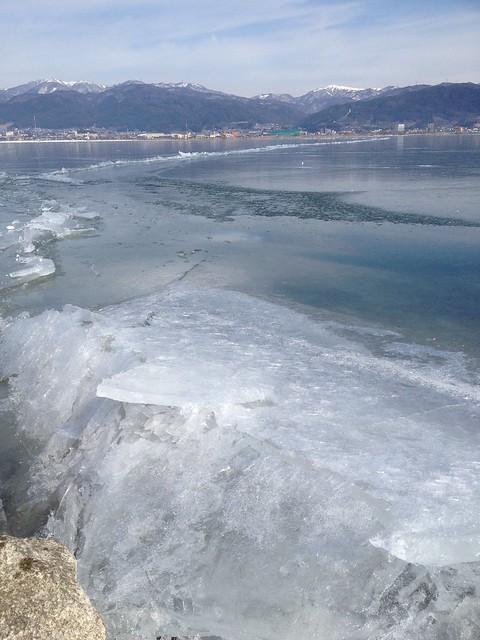 |
| Omiwatari by Kainoki Kaede /flickr in 2012 |
On January 22th, Omiwatari(御神渡り, The God's Crossing) appeared in Lake Suwa, Nagano Prefecture for the second consecutive year. It's cracks that form in the ice on Lake Suwa and appears only in the killer winter.
(More information about Omiwatari can be found at
http://ichinen-fourseasonsinjapan.blogspot.jp/2012/02/omiwatari.html)
The oldest record of the phenomenon is described in a report from a Suwa Shrine's priest to the feudal government at the time in 1397. Omiwatari has been observed by Suwa Shrine every year since 1443 although its observation was interrupted several times.
Shinto priests judge a fortune about a good or bad harvest for the year by the traces of omiwatari. On the 25th, the chief priest of Yatsurugi Jinja Shrine(八剣神社) divined the year's harvest by watching the traces. The result was that the crops will turn out slightly above average and hopeful signs in the world are looming.






